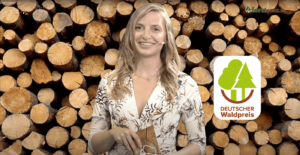It’s a familiar situation: weeks of preparation, a well thought-out cultural program, committed participants, but you only physically reach a fraction of your potential audience. Not because there is a lack of interest. Quite the opposite: many would have liked to take part, but distance, for example, makes it impossible.
At the same time, another question arises:
How often is it actually possible to realize an event in such a way that both the audience on site and online really feel involved – without compromises and without a supporting role?
With the SPOTLIGHT³ event, the Coordination Office for Digitization in Art & Culture (Bavarian State Ministry of Science and the Arts) proves that digital cultural mediation can be much more than it has been so far. In this series of events on digital cultural mediation, new digital strategies, games, AR applications and developed prototypes were tested in three different Bavarian museums, all of them hybrid.
In this article, we take a look behind the scenes – and show how real participation in hybrid cultural events can be achieved.
When technology becomes a bridge
Imagine being able to make your exhibition accessible not only to visitors on site, but also to hundreds of people at the same time – who can take part from the comfort of their own homes. And in such a lively way that both groups have the feeling of being right in the middle of it. This is exactly what Stream1 has achieved with three extraordinary projects – each with its own innovative approach.
At the Frauenau Glass Museum, an interactive children’s program brought the glassworks spirit Durandl to life. While visitors were guided through the exhibition on site, viewers at home could join in via livestream and ask their questions in a live chat. Light projections, animations and multimedia stations transformed the museum visit into a captivating exhibition experience.
The Munich State Coin Collection took its guests on a journey through Germany – to the cities and buildings on the 2-euro coins. As a special highlight, the second “Expedition Numismatika” awaits those who have collected enough coins: a virtual tour through Portugal, Spain and Italy.
Porzellanikon Selb concluded the series with its augmented reality application “Window into the past”. Equipped with tablets and accompanied by avatars, visitors explored the museum’s outdoor area – and immersed themselves in the day-to-day work of a historic porcelain factory. Thanks to innovative wireless cameras, digital participants also felt like they were right in the middle of the action.
This creative combination of avatars, real-time interaction and hybrid tours blurred the boundaries between real and digital. The accompanying keynote on “Live performance and digital technologies” also demonstrated that modern museum visits are becoming interactive experiences – full of stories about technology, craftsmanship and the people behind them.
More than just streaming – creating real participation
This is the key difference to conventional livestreams: while many organizers treat their online viewers as passive consumers, this event actively involved the digital audience at all three stations – for example through live surveys, chats and a separate moderation for digital guests.
In our guide to interactive livestreams for museums, we show you how to use such interactive formats to bring culture to life digitally. These tools ensured that no one felt like they were just watching.
The visible integration of the online audience via monitors in the event room was also a clever move. Suddenly, the digital participants were no longer invisible, but became a real part of the event. This created a completely new dynamic and showed everyone involved that no one was being forgotten.
Why hybrid events are revolutionizing your reach
Think back to your last cultural event. How many people would have liked to attend but couldn’t? Hybrid formats solve this problem in one fell swoop. Suddenly you can reach people you would never have reached before, without sacrificing the atmosphere and intimacy of face-to-face events.
At the same time, you offer your content a second chance: what begins as a live event becomes a permanent digital asset thanks to the recording. People can still experience, share and talk about your event weeks later. That is sustainable cultural mediation.
The key lies in professional implementation
Of course, you can also set up a camera yourself and stream via Facebook Live. But let’s be honest: at best, this will only achieve the level of a vacation video. Professional hybrid events require well thought-out technology, experienced direction and, above all, an understanding of how online and offline experiences complement each other perfectly.
The collaboration between the Coordination Office for Digitization in Art & Culture and Stream1 as part of the three-part event SPOTLIGHT³ shows what is possible when cultural institutions and technology experts pull together. The result is events that do justice to both worlds and set new standards for digital cultural mediation.
Culture is an encounter – digital and analog
In the end, it’s not about whether culture is digital or analog. It’s about reaching, inspiring and connecting people. Hybrid events expand the ways in which these encounters can take place and make culture accessible to everyone.
The future of cultural mediation is neither purely digital nor exclusively analog. It is hybrid, interactive and inclusive. And it starts right now.
Ready to take your event into the future?
With Stream1, you can create immersive experiences that inspire visitors both on site and online. Let’s create new spaces for culture together where the digital and analog worlds connect.

By loading the video, you agree to YouTube's privacy policy.
Learn more


